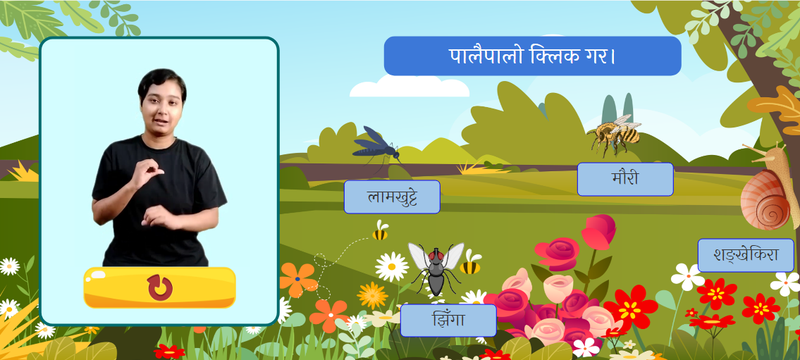By Urja Shrestha, Intern at OLE Nepal | September 2022
As a part of our vision to make education accessible and inclusive, we started a project to create digital content that can assist students to learn the Nepali Sign Language (NSL). Known as Sanketik Sikai, the collection consists of 60 modules of digital activities embedded with sign language videos for young students with hearing impairments.
September 23 is observed as the International Day of Sign Languages. Aiming to unite individuals with full or partial hearing impairments, users of sign language, and families of both groups, the day is celebrated every year to bring awareness to deaf communities.
More than 300,000 people in Nepal are deaf or have hearing issues, according to the National Federation of Deaf Nepal. One of the highest hearing impairment rates in Asia is in Nepal, where 16.6% of the population is affected. Unfortunately, a large number of these individuals are left behind, especially in terms of educational growth. Due to the lack of resources and access to good, quality education, a lot of young people in deaf communities are unable to have higher hopes for their future. It’s not that they don’t have that drive or aptitude, it’s that they don’t have the right support to get there.
Nowadays, classrooms for general education are broadening. Children from various backgrounds and a range of disabilities are inculcated into the general education setting. Although this seems like a step forward in inclusion, it has actually been challenging for one teacher to instruct all of the students using just one kind of learning style.

So why our “Sanketik Sikai” NSL chapters?
The Sangketik Sikai collection, which teaches young learners the Nepali alphabet and other signs for different things, actions, expressions, and relations so they can continue their education, is divided into lesson and vocabulary sections. Our chapters not only teach learners the basics of communication in sign language, but they’re enriching and inclusive. Out of the 60 chapters, the collection covers daily life vocabulary, grammar, simple math, along with short stories about the characters who help the kids learn the content.
Through our content, NSL can have a better grasp on comprehension and language.
Sambridhi Shrestha, who worked as an NSL interpreter and helped create NSL content at OLE Nepal says, “While being involved in the deaf community, I realized the problems deaf people face- like lack of interpreters, lack of quality education, an inability to communicate with others and their parents, not getting proper rights and so on. Due to these problems their community is more vulnerable than what we see conventionally.”
Sambridhi explained that because of the lack of access and understanding, many individuals who rely on NSL end up being held back in grades. With regards to this, when most kids their age are advancing to higher grades, they are still usually studying in elementary levels.
We here at OLE Nepal want to change that. We provide inclusive digital education materials to overcome these barriers. Our digital NSL content includes child-friendly images and visuals which are inclusive and are easy to learn from. Not only that, teachers, parents, family members, and friends of NSL users can also make use of the content to communicate better with each other. Communication is a two-way bridge, and now families and friends can also learn some basic signs to be more involved with NSL users.
Additionally, learning sign language enables one to embrace diversity and promote inclusion for all. We hope that with our content, deaf communities in Nepal can see themselves represented better. Through one small step at a time, we can let our hands lead the way. We can not just bridge the gaps in education, but build better bridges for families and communities, so there is equal access to learning, support, and growth.
You can access our Nepali Sign Language content, Sanketik Sikai through this link.